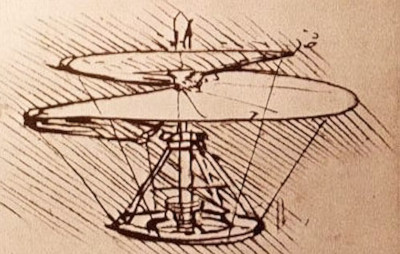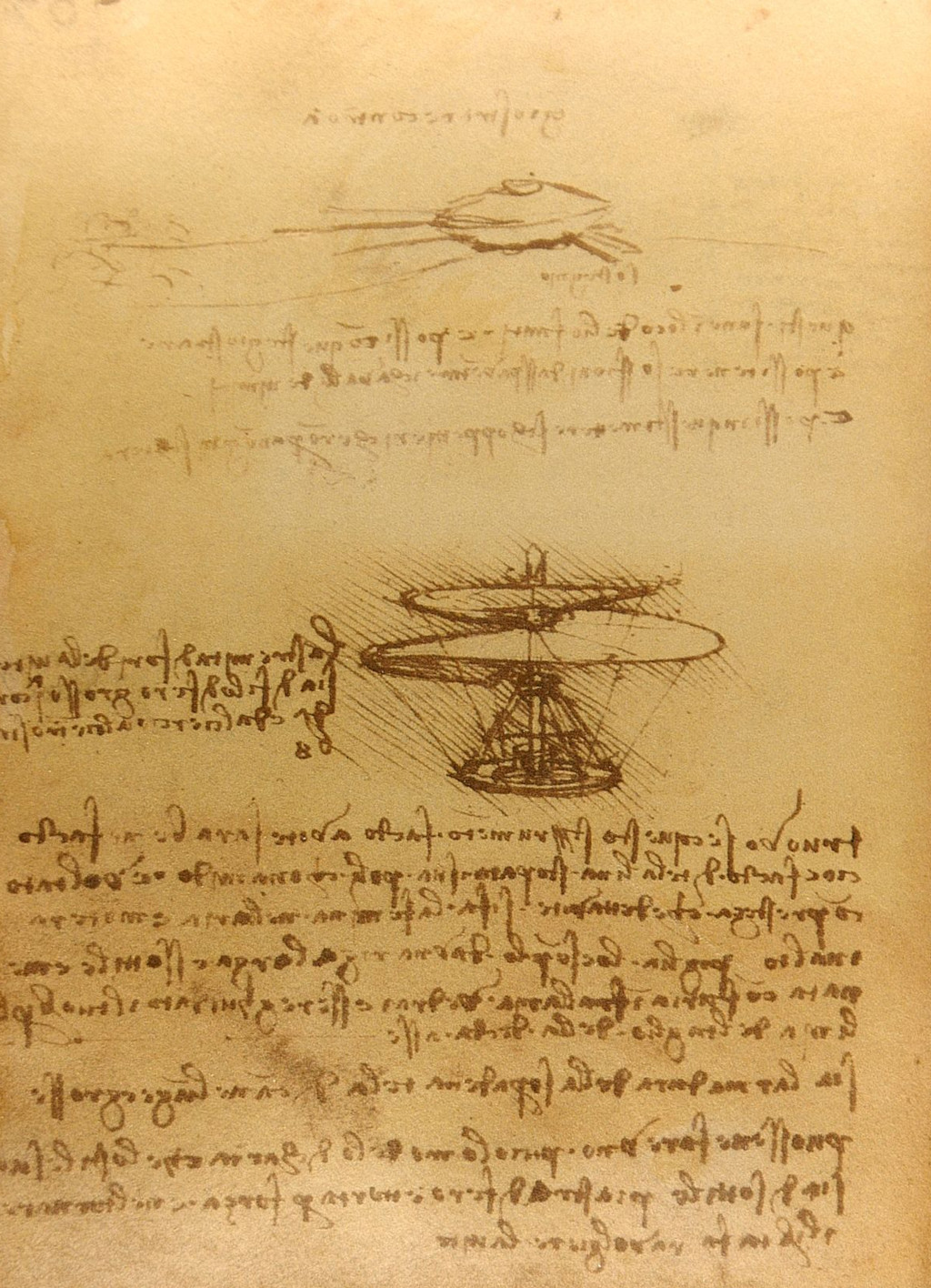Leonardo da Vinci became obsessed with human flight, and designed a number of flying machines, one of which bears considerable similarities with modern-day helicopters. It was known as the Aerial Screw.
Introduction
The artist/inventor studied the human and animal anatomies in considerable detail throughout his career, attempting to understand fully their inner workings. Birds were of particular interest to Da Vinci, and he sketched their differing characteristics across a variety of species.
Da Vinci would eventually become intrigued by the methods by which birds could fly, seemingly with relatively little effort. He wanted to give the same ability to man, and set about designing a machine that could facilitate this dream. The inventor ran into issues in his designs, and would slowly switch to alternative ideas when he realised the challenges were insurmountable.
The specific idea that we will address here was known as the Aerial Screw, and many have termed is as "Da Vinci's Helicopter", because of how certain principles within the design marry up with modern-day helicopter technology. It is important to remember that whilst Da Vinci's inventions were never built into successful products, many of the discoveries that he made during his studies would help later generations of scientists and inventors.
Indeed, for many centuries the artist was only remembered as a painter, but over time his notes and documents have been better understood and the impact of his studies have been continually linked to later developments within the field of engineering. Da Vinci was also restricted by the types of materials available at the time, which were generally too heavy to make his ideas work, whilst today they would have had a much greater chance of success.
Aside from his aerial screw, aka helicoper design, Da Vinci also produced an ornithopter, complete with flapping wings, plus a parachute and a glider design. Many of these have been successfully produced in the centuries since his death, using lighter modern materials. The cult following enjoyed by this Renaissance Man has led to many engineers attempting to bring his ideas to life, further strengthening his legacy.
Experts in the field of engineering continue to disagree over how similar Da Vinci's design is to a modern helicopter, and how much influence his ideas actually had on others, but you can make your own mind up below, with a series of his drawings included, alongside notes he made on how he intended these ideas to work in practice, and from what materials he intended the aerial screw to be made.
This article examines Da Vinci's helicopter designs, and discusses the engineering ideas behind what others have called his Aerial Screw. We also place his helicopter in context with other flight inventions, and consider which ones might have had the best change of success. Finally, we touch on the influence left behind by Da Vinci's work within this field, and how other inventors may have evolved his work with new tweaks of their own.
Table of Contents
- Introduction
- How did Da Vinci's Helicopter work?
- Da Vinci's Drawings of Helicopters
- Why did Leonardo design a helicopter?
- When were the earliest designs for helicopters?
- What other flying machines did Leonardo design?
- When was the first successful helicopter flight?
- Did Leonardo fly his helicopter?
- References
How did Da Vinci's Helicopter work?
It is the principle behind Da Vinci's aerial screw which has led to many comparing the design to a modern helicopter. The screw would work against the force of air being applied from above and to the side, creating a rotor effect that would then lift the machine into the air.
The idea itself is derived from a water screw and Da Vinci had already studied the flow of water within his engineering studies. Da Vinci also understood air flow, having learnt about flight in nature earlier on in his career, and so believed that the two topics could be merged together to create this flying machine.
Leonardo left a number of notes alongside his drawings of an early helicopter, and he suggested lighter material, such as linen, could be used in its construction. His belief was that if the rotor could rotate fast enough, in acting against the flow of air, then there would be enough power to lift the item into the air.
A number of models have been constructed in the past century in Europe that have turned his ideas into prototypes, and better explain his original intentions. These look more polished that Da Vinci's original musings, but essentially follow his principles and have shown the potential for this technique to work effectively in life-size scale.
Da Vinci's Drawings of Helicopters
The image below captures Da Vinci's drawing of a helicopter, using the aerial screw method. It is currently owned by the Institut de France, as part of a larger manuscript. As shown here, Da Vinci would regularly add notes besides his designs, helping historians to understand the engineering principles that lay behind his brushes of pen and ink.
Da Vinci used different types of drawing materials across his career, and they would serve different purposes. His use of pen and ink, as found below, tended to be far looser, more creative ideas where precision was not yet required. He would then use metalpoint for more accurate work, where greater discipline was needed.
Why did Leonardo design a helicopter?
Leonardo's most prominent employer was Ludovico Sforza, Duke of Milan, and the two would collaborate on a large number of projects. Most are aware of the paintings that Da Vinci produced upon request of his donor, but he also served as a military engineer for a number of years in the late 15th century.
The aerial screw design was attempting to create manmade flight into a manner that could bring an advantage to Sforza in the battlefield. It is unlikely that Leonardo would have been enthusiastic about his designs being used in this way, but this was the task that he was given at the time. Da Vinci produced a number of other military inventions, such as a variety of landbased weapons, but the helicopter might have been used to attack enemy lines from above, which would have been groundbreaking within warfare of that period.
When were the earliest designs for helicopters?
The earliest designs for helicopters appeared within China in around 400BC, using a spinning top method for flight which is similar to the approach taken here by Da Vinci. These early interpretations were more used for childen's toys but the principles would later be investigated as a means to human flight.
Whilst Da Vinci's ideas were helpful, it may have been the Chinese influences which led to an evolution of the idea in more recent centuries, leading up to the working helicopters that we have today. The principles remained strong but required advancements in materials before a machine could be light and strong enough to hover for an extended period of time.
What other flying machines did Leonardo design?
Leonardo continually returned to the theme of flight over a number of decades, never quite mastering a design that he felt could work effectively in a commercial capacity. The engineer would come up with new ideas and test them on paper, pinpointing issues prior to even building a prototype. He often located potential pitfalls through his theories alone, but was generally unable to solve these problems and continually moved on to new ideas.
Da Vinci's biggest challenge was in the materials available in Italy at that time. These were not suitable for any of the designs that he came up with, mainly because of their weight. It was only several centuries after his death that some of the sound principles that he came up with could have been turned into working prototypes. Some of the flying machine ideas that he came up with, besides the helicopter, were the likes of an ornithopter, a glider, flying machines powered by pedal power and also giant kite.
Although Da Vinci was particularly passionate about creating human flight, he also became involved in other engineering fields, most notably in military combat. He even went the other way to his flight machines, and tried to enable humans to swim and walk through deep oceans for extended periods of time.
When was the first successful helicopter flight?
The first successful flight of a helicopter was recorded on the 14th of September, 1939. Engineer Igor Sikorsky designed this early prototype and it flew its maiden journey in the US. This shell-like creation included the same fundamental design that continues to be used today, many decades later.
Did Leonardo fly his helicopter?
As with most of Da Vinci's inventions, sadly, his helicopter design would never be used. The idea remained hidden in his notes for a number of years before being discovered when his manuscripts were documented for the first time. Engineers may well have been inspired by these ideas, and influenced in creating workable solutions of their own.
References
- Leonardo. The Complete Paintings and Drawings, Frank Zöllner & Johannes Nathan, Taschen
- Leonardo da Vinci, Walter Isaacson





